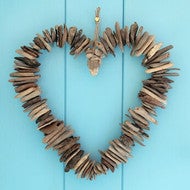Designing With Driftwood
Aug 1st 2018
 Taking a walk along any beach or lake shore can yield a bevy of interesting inventory. Whether you find a gorgeous sea shell, an old work boot or a message in a bottle sent out before email was a thing, each piece of 'treasure' has a story associated with it. While scraping for that work boot, you may have had to push aside or dig out some pieces of driftwood and without knowing it overlooked the biggest haul of all.
Taking a walk along any beach or lake shore can yield a bevy of interesting inventory. Whether you find a gorgeous sea shell, an old work boot or a message in a bottle sent out before email was a thing, each piece of 'treasure' has a story associated with it. While scraping for that work boot, you may have had to push aside or dig out some pieces of driftwood and without knowing it overlooked the biggest haul of all.
Wood floating in the sea for (sometimes) decades is known as driftwood and has quickly become one of the most unique and desirable design materials. Weathered driftwood instantly adds an old-world feel to any type of interior setup and the only limits for use is the finder's creativity. Driftwood has become so popular that even new construction processes are using items like faux-driftwood style header beams. Many home crafters are consistently exploring ways to finish store-bought wood so that it gains the instant weathered looks similar to what the underwater lumber had to earn during years at sea.
What's the Driftwood Allure?
Some people might look at your use of driftwood design and think you've fallen on hard times or that you're in the initial phases of creating an aquarium theme in your living room. The truth is that driftwood is a very appealing wood decor option for a number of reasons:
- Availability. Smooth textured driftwood is optimal for all sorts of designs as it combines a surface that's rough and weathered looking but pleasant to rub your hands over. Best of all, this kind of driftwood is found washed ashore on banks and really has an unlimited supply if you've got a canoe and some free time.
- Price. If you were to go to a manufacturer and commission a piece of lumber to appear like driftwood, you'd be paying multiple fees in processing, machining, and finishing. Natural driftwood, though, is free for the hauling from your local rivers and lakes.
- Uniqueness. Every piece of driftwood tells a story; anything from how you came up with the design ideas to how you dug the piece of lumber out of a mud suction and a smallmouth bass swam across your hand and scared the bejeebers out of you.
- Brings Out Creativity. Many times a successful songwriter will first have the music in her head and then create lyrics to go with it instead of the other way around. Similarly, you don't really know what shape/size/texture piece of driftwood you're going to find until you dig it out of the sand. Instead of design materials, your creativity adapts to materials design, which can be very rewarding.
Designing With Driftwood
So you've got chunks of beautiful driftwood strewn out about your lawn, now what? First off, driftwood decorating really does go well with a coastal theme, which makes it perfect for lake houses, beach houses or fishing cabins. That being said, the "weathered and aged" design trend is one that's very popular in both traditional and even modern homes, so you really can't go wrong with an attention grabbing driftwood centerpiece.
Some of the most popular ways to incorporate driftwood into your existing decor is by combining the wood with light. Driftwood lamps are very common and a driftwood pendant light combines accent lighting with rustic decor: a win-win. Keep in mind is that the main premise behind designing with driftwood is bringing the outside to the inside, so picture frames, shelves, cabinets, sconces, benches, and even railings are a great way to use natural wood for something you'd need on the interior anyway. Along those same lines, any sort of driftwood art is very popular and potentially something you could get good at and start to sell.
One thing to remember is that the natural weathered beauty and subtle sophistication of driftwood makes it a great design addition even just being piled up in a living room corner. There's really no wrong way to design with the interesting wood so you might as well just try. After all, if you don't like the look...you can always throw it back.

